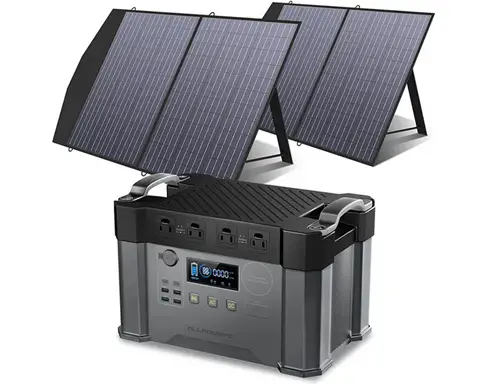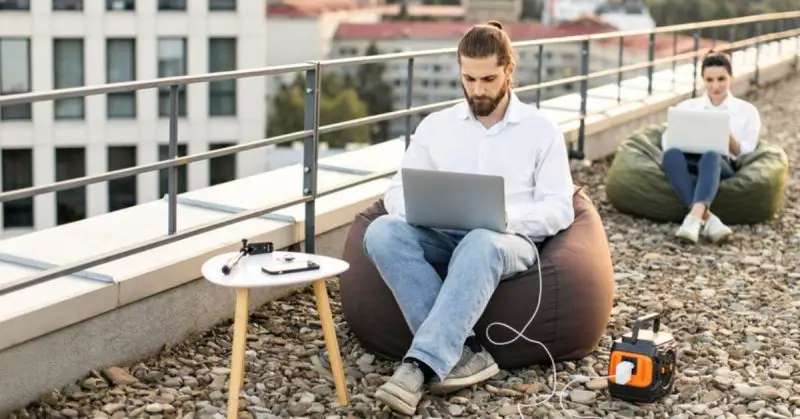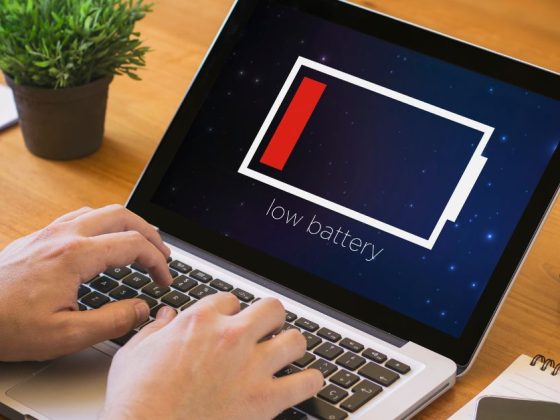Imagine this: you’re in a café with your laptop, smartphone, tablet, and camera all lined up. The only outlet is across the room, and the power strip is already full. Or you’re filming outdoors, away from walls and plugs, and your gear’s battery bar is blinking red. Now picture a sleek box next to you that just keeps running everything — no outlets, no scrambling, no downtime. That’s the promise of the portable powerstation.
In this article, we’ll dive into how a portable powerstation can transform your gadget life. We’ll explore what they are, how they work, why they matter for a tech-enthusiast like you, examine top models (including ALLPOWERS S2000, EcoFlow DELTA 2, and others), give you hands-on tips and real use-cases, highlight common mistakes to avoid, and peek at what’s next. Whether you’re editing videos, powering smart devices, traveling or prepping for power outages—you’ll walk away knowing exactly how to integrate a portable powerstation into your workflow and lifestyle.
What Is a Portable Powerstation?
At its core, a portable powerstation is a high-capacity rechargeable battery pack with integrated inverter(s) and multiple output ports (AC, USB-C, USB-A, sometimes DC, and solar input), designed to power or charge your gadgets when conventional mains power either isn’t available or isn’t convenient.
Key components:
-
Battery pack: Usually lithium-ion (or newer chemistries) rated in watt-hours (Wh) — more Wh means more runtime.
-
Inverter: Converts stored DC power in the battery to AC (for wall-plug devices) or provides direct DC/USB outputs for gadgets.
-
Output ports: AC outlets (for laptops, monitors, even small appliances), USB-C/USB-A for phones, tablets, etc.
-
Recharge options: Mains AC input, car/truck input, sometimes solar panel input (for outdoor/off-grid use).
-
Smart features: Some include monitoring apps, battery management systems (BMS), surge protection, UPS mode (uninterruptible power supply) for critical devices.
Why this matters for your gadget life:
-
Unplug with confidence: You’re not tethered to wall outlets.
-
Flexible location: You can set up your laptop, tablet, or editing rig anywhere in a café, coworking space, van or rooftop.
-
Backup power: In case of outages (frequent or unexpected), your essential gadgets stay alive.
-
Charge multiple devices: One “hub” for all your kit rather than juggling multiple chargers and outlets.
-
Outdoor creative freedom: Power your gear where there are no sockets — perfect for travel, shooting, and remote work.
In short: for a tech-enthusiast who loves gear, flexibility, and staying connected— a portable powerstation isn’t just a nice-to-have, it can become a central piece of your kit.
Why You Should Care?
Let’s zoom in on the “why” from a gadget-lover perspective. If you own multiple devices, travel, work remotely, shoot content, or just dislike cord-hunting, this section speaks to you.
1. Gear overload = more demand for power
Think about your typical setup: a high-performance laptop, external SSDs, cameras or drones, smartphone(s), monitors, maybe, smart speaker, charger for gadgets, maybe even lighting. All of this draws power. Without a dedicated solution, you’ll constantly be hunting for a free socket, extension lead, or worrying about battery life. A portable powerstation solves that.
2. Travel and location-independence
If you’re moving between home, café, co-working space, outdoor shoots, maybe switching between the US and the UK (or Philippines, if that’s your base)—outlets differ, sockets differ, accessibility varies. A portable powerstation gives you consistency. You plug into it, not hunt for wall power.
3. Power interruptions or unpredictable infrastructure
Whether you live in a place where power outages happen (or you travel to one), having a powerstation gives you backup. Your router stays up. Your laptop stays charged. The light doesn’t flick off during an important call. From a productivity perspective, that’s huge.
4. Creative freedom + outdoor shoots
Go to a park, rooftop, beach-side café, or countryside shoot – your gear still needs power. A portable powerstation becomes the silent assistant, powering your laptop, drone charger, lights. No generator noise, no petrol smell—just clean, portable electricity.
5. Tech evolution & longevity of investment
Battery/energy storage tech is getting better. What you invest in now will get more use over time. As solar panels, USB-C PD high-wattage charging, and smart home integration improve, your portable powerstation will continue to serve you for years.
In short, For tech enthusiasts, a portable powerstation equals independence, mobility, and efficiency. It allows your gadgets to work how you want—wherever you are.
How a Portable Powerstation Works — Tech Insight
Let’s pull back the hood for a moment and dig into how these units work and what specs matter. No unnecessary jargon, but enough detail to feel like you understand.
Battery & capacity
-
Capacity is measured in watt-hours (Wh). Example: a 1,000 Wh unit theoretically can deliver 1,000 watts for one hour, or 100 watts for 10 hours (ignore losses for simplicity).
-
Battery chemistry matters:
-
Traditional lithium-ion (NCM, etc) — high energy density but may have fewer cycles.
-
LiFePO₄ (Lithium Iron Phosphate) — slightly lower density, but much longer lifespan and safer.
-
-
Example: Some units claim 2,500+ cycles to 80% capacity or more. The ALLPOWERS S2000 claims 2,500+ life cycles to 80% capacity.
Inverter & continuous vs surge output
-
Continuous output: What the unit can sustain.
-
Surge output (peak): When devices start, they might draw more (e.g., a refrigerator or power tool). Example: The ALLPOWERS S2000 offers 2,000 W continuous and up to 4,000 W surge.
-
Pure sine wave inverter = safe and clean power for sensitive electronics.
Ports & Outputs
-
AC outlets: For laptops, monitors, chargers, and some small appliances.
-
USB-C: Preferably PD (Power Delivery) high wattage (e.g., 100W) for modern laptops/tablets. Example: S2000 has PD 100W max.
-
USB-A: For phones, older gear.
-
Car 12V outlets or DC ports: For automotive, mobile setups.
-
Input ports: AC charging, solar/MPPT input, car input.
Recharging & input options
-
AC Recharge: Plug into the wall; faster inputs mean faster turnaround. Example: The EcoFlow DELTA 2 can recharge to 80% in ~50 minutes.
-
Solar input: Great for outdoor/off-grid use; check wattage and panel compatibility. Example: the S2000 supports up to ~500W solar input.
-
Car input or other modes: Useful when traveling.
Efficiency, losses & practical run-time
-
Real-world runtime is less than capacity ÷ load because of losses and inverter inefficiencies (often around 80-90% efficiency).
-
Use this formula: Runtime (hours) ≈ Capacity (Wh) ÷ Device Load (W) × Efficiency Factor (~0.85).
-
Example: Laptop draws 60 W. You have a 1,500 Wh powerstation: 1,500 ÷ 60 ≈ 25 h * 0.85 ≈ ~21 h in ideal conditions (but practical factors may reduce further).
Safety, life-cycle, and management
-
BMS: monitors temperature, prevents overcharge/discharge, and ensures safe operation.
-
Cycle life: Look for how many full discharge/charge cycles until capacity drops to 80%. Longer is better.
-
Maintenance: Avoid storing fully discharged or overcharged for long periods; keep it in a moderate temperature; use it occasionally.
Real-World Use Cases: How a Portable Powerstation Actually Changes Gadget Life
I want to bring this home with realistic scenarios where portable powerstations deliver value — especially for a tech-enthusiast.
Scenario 1: Coworking café with limited outlets
You’re working at a café. You bring your laptop (60W charger), tablet, smartphone, maybe an external monitor (20W), and want to edit, write, and research for several hours. Rather than hunt for the one free outlet, you plug your gear into the powerstation and use its AC and USB ports. You remain mobile, move seats if you like, no longer constrained. Your gadgets stay powered and ready.
Scenario 2: Outdoor location shoot or remote work session
You’re doing a lifestyle photo or video shoot outside. You have a camera rig, lighting, laptop for on-site edits. There’s no wall outlet. You bring a portable powerstation (say 1.5 kWh class). Plug everything in, shoot for hours, review footage, and make edits. After the shoot, you recharge the powerstation via AC once you’re back, or if you’re staying outdoors, you use a connected solar panel. Freedom to set up anywhere.
Scenario 3: Travel between the US/UK/international
You’re switching between the United States and the United Kingdom for work, carrying your laptop, tablet, smartphone, and smart accessories. Hotel sockets are limited; you may need adaptors. A portable powerstation lets you plug into one source (the station) and then plug all your devices into it. You standardize your charging and power routine, minimize adapters and outlet-hunting. It becomes part of your travel gear.
Scenario 4: Home backup and productivity resilience
Suppose your region has occasional power interruptions. Instead of scrambling, you’ve got a portable powerstation in your home office. Your router, laptop, and external drive are connected. Power goes out: you continue working uninterrupted. You meet deadlines, stay connected, avoid downtime. For a content writer and publisher, that kind of reliability is a productivity win.
Real-life product example: ALLPOWERS S2000
Take the ALLPOWERS S2000 as an instance: It offers 1,500 Wh capacity, 2,000W continuous AC output, and 4,000W surge. That means you could plug in a serious laptop + editing monitor + camera + lights and run them for hours. The S2000 also supports PD USB-C 100W, multiple USB ports, and solar input up to ~500W. It’s priced well for what it delivers. For you—who works with gadgets and travels—it ticks many boxes.
Example: Tech-enthusiast scenario
Let’s say your setup: Laptop (65W), external monitor (30W), smartphone (10W), camera + charger (20W) total = ~125W. With the S2000 (1,500Wh) you get: 1,500 ÷ 125 ≈ 12 hours (minus losses) ~10 hours in real use. That covers a full day of editing or workflow without wall power. Combine with AC + solar recharge to cover your next session. That’s freedom.
How to Choose the Right Portable Powerstation
Now that you understand what they are and why they matter, let’s walk through how you choose one — especially as a gadget-loving, travel-aware tech enthusiast.
Step 1: Clarify your use case
Ask yourself:
-
Which devices will I power? (Laptop, monitor, smartphone, camera, lights, maybe a small appliance)
-
How long do I want the runtime without recharge? 2 hours? Half-day? Full day?
-
Where will I use it? Home, travel, outdoor, van/vehicle, remote shoot?
-
Will I recharge via mains only, or also solar/car?
-
Do I need AC outlets, or will USB-C/USB-A suffice for lighter gear?
Step 2: Match capacity and output to your gear
-
Calculate your loads: check power draw (watts) for your devices (check laptop charger rating, monitor wattage, etc).
-
Use formula: Required Wh ≈ Load (W) × Desired hours ÷ Efficiency factor (~0.85)
-
Choose a unit with a continuous output higher than your peak device load. If you plug in something that draws 1,500W and your station has 1,000W continuous, you’ll overload it.
-
Example: If you want to run laptop (65W) + monitor (30W) + phone + accessories (10W) for 8 hours: total 105W × 8 = 840Wh ÷ 0.85 ≈ ~1,000Wh minimum. So you’d pick a ~1,000Wh (or more) capacity unit.
Step 3: Consider recharge time and input flexibility
-
If you only ever charge via wall AC, then fast AC recharge is nice. Example: EcoFlow DELTA 2 can recharge to 80% in ~50 minutes.
-
If you’ll use solar panels or car input (travel, remote work), check solar input wattage & compatibility. The S2000 supports ~500W solar input.
-
Also, check recharge time: a longer recharge time means a longer wait between uses.
Step 4: Ports & features that matter
-
AC outlets: How many? What wattage?
-
USB-C: High wattage (100W or more) = good for modern laptops.
-
USB-A: For phones/older devices.
-
Car output/DC: Useful for travel gear.
-
Pass-through charging (charge the station while powering devices) + UPS mode: Good features for workflow. The S2000 Pro includes UPS mode.
-
App/monitoring: Keeps track of power usage, recharge cycles, and controls outputs remotely.
-
Build, weight, portability: If you’ll carry it around, lighter is better, but higher capacity typically = heavier.
Step 5: Brand, warranty, battery life & longevity
-
Look for reputable brands with good service/support.
-
Battery chemistry matters: LiFePO₄ typically lasts longer than older lithium-ion. Example: The EcoFlow DELTA 2 uses LFP chemistry and promises high cycle life.
-
Warranty and reliability: Check how many cycles until capacity drops to 80%. The S2000 claims 2,500+ cycles to 80%.
-
Future expandability: Some models allow extra battery packs (e.g., EcoFlow DELTA 2’s “Extra Battery Port”).
Step 6: Budget vs value
-
Smaller capacity units cost less, but may not serve your full workflow.
-
Higher capacity or advanced features cost more but deliver more flexibility.
-
If you’re a tech enthusiast with heavy gadget use, consider spending a bit more for the freedom.
Quick List
Here are models you should know to help you benchmark:

-
ALLPOWERS S2000 Portable Power Station: 1,500 Wh capacity, 2,000 W continuous AC (4,000 W surge), support for PD 100W USB-C, solar input ~500W. Great balance of capacity, features, and price for tech enthusiasts.
-
EcoFlow DELTA 2 Portable Power Station: 1,024 Wh (or around that size) capacity, 1,800 W continuous AC, fast recharge (80% in ~50 mins), smart app integration. A top choice for travel + creator work.
-
EcoFlow DELTA 2 Max Portable Power Station: Bigger capacity (~2,048 Wh), 2,400 W AC, dual solar input, long-life chemistry — for more demanding setups.
-
BLUETTI EB3A Portable Power Station: A budget/lightweight alternative for lighter gadget use or travel; less capacity but more portability.
By comparing, you can pick what “tier” fits your gadget life.
Practical Tips & Step-by-Step: How to Make It Work for You
Here’s a hands-on workflow to integrate a portable powerstation into your gadget routine.
1. Initial Setup
-
Unbox and inspect: check for damage and ensure all cables and instructions are included.
-
Fully charge the unit before first heavy use – helps calibrate battery and get you comfortable.
-
Register with the manufacturer for warranty & firmware updates (if applicable).
-
Read the manual: find load rating, ventilation requirements, safe load vs surge.
2. Daily Use Workflow
-
Plug in your gear: If you’re working at your desk/home/remote site, plug your laptop, monitor, phone charger, external SSD, and lights (if you use them) into the powerstation.
-
Monitor the load: Many stations show current wattage or remaining runtime. Aim to keep the load below the continuous rating.
-
Manage efficiency: Turn off unused devices (monitor when editing off, lights when done) to extend runtime.
-
Recharge when you’re done or offline: Keep the station ready for next session.
3. Travel or On-location Use
-
Pack smart: If you travel between the US/UK/international, bring appropriate plug adaptors for AC input (if needed) and distribute weight (some units weigh >12 kg).
-
Use a car input or solar if you’ll be using it in remote areas or during transit.
-
Choose your station location carefully: Ventilated area, avoid high heat or direct sunlight if the battery inside the case is stressed.
-
Use the station as your hub: Plug charger bricks into it, then one cord from the station to the wall (or car) input when recharging. Helps centralize your setup.
4. Backup & Emergency Use
-
Identify key devices: router/modem (for connectivity), laptop for working or emergencies, phone, maybe lights.
-
Pre-connect: Have your station connected (or at least ready) so you can hit “on” when the outage happens.
-
Maintain: Periodically test your station (discharge some load, recharge) so you know how long it lasts.
-
Plan for recharge: If power comes back in 2–3 hours, you’re covered. If longer, consider a solar panel or a combination recharge method.
5. Maintenance & Best Practices
-
Store at ~50% charge if you won’t use it for weeks/months (check manufacturer recommendation).
-
Avoid extreme temperatures: Many units degrade faster if stored or used in very hot (>40°C) or very cold (<0°C) environments.
-
Update firmware if supported: App-connected units sometimes receive performance or safety updates.
-
Use it regularly: Batteries prefer being used; leaving them idle at full/zero may reduce lifespan.
-
Keep outlets and ports clean and dry, especially if you travel or use them outdoors.
6. Workflow Integration for You (Content-Writer/Tech Enthusiast)
Given your role (loving gadgets, travel between US and/UK, content publishing):
-
Pack a “travel kit” version: maybe a mid-capacity station (~1,000–1,500 Wh) for your laptop + phone + external drive + camera, plus a smaller one for trips.
-
Use the station in hotel rooms/co-working spaces: Plug your devices into it and then recharge it overnight. Simplifies sockets and adaptors.
-
Use it to “edit anywhere”: café terrace, rooftop, park – you have power for laptop + SSD + backup drive + phone charger without searching for a wall.
-
Use it for outdoor or travel shoots: Trip to the countryside, beach, rooftop – you have a mobile workstation set up powered by your station.
-
Make it part of your home-office infrastructure: Your station sits next to your desk; during an outage, you switch seamlessly; during travel, you mobilize it.
Common Mistakes & Pitfalls (and How to Avoid Them)
Even with great gear, it’s easy to make mistakes. Here are pitfalls to watch out for and how you avoid them.
🚫 Mistake 1: Buying too small a capacity
If you assume your phone charger is all you’ll need, but then pack a laptop + monitor + lights and expect 8+ hours, you’ll come up short. Use load calculations (see above) and err on the side of extra capacity.
🚫 Mistake 2: Overloading the station
Plugging in devices that draw more than the continuous output rating can cause overheating, early shutdown, or damage. Always check continuous ratings (not just “peak”).
🚫 Mistake 3: Expecting unlimited “generator-like” power
Remember you’re working with a battery. Once capacity is used up, you must recharge. If you plan multi-day off-grid work without recharge sources, you’ll hit limits.
🚫 Mistake 4: Neglecting recharge speed & input
If your station takes 10-12 hours to recharge, but you only have 4 hours between sessions, you’ll bottleneck — especially if you travel. Fast AC recharge or solar input is a must.
🚫 Mistake 5: Ignoring travel/airport rules
Many airlines restrict battery capacity (Wh limit) in carry-on or checked bags. Large powerstations may be prohibited or subject to special rules. Always check airline policies.
🚫 Mistake 6: Poor storage/maintenance
Leaving your station fully discharged for months, storing in extreme heat/cold, skipping firmware updates, or never using it until an emergency—all reduce lifespan or leave you with a non-functional backup.
FAQ Section
Q: Can I plug a desktop computer into a portable powerstation?
A: Possibly yes, but desktops often draw high current (200–400W or more) and may have surge/power-on spikes. You’d need a high-capacity station (e.g., ~2,000Wh+) with sufficient continuous output.
Q: How long will the battery last (in terms of years)?
A: Depends on chemistry and usage. Many units now claim 2,500 to 3,000 full cycles to 80% capacity. For example, the S2000 claims 2,500+ cycles. With daily use, 3,000 cycles = ~8 years. With occasional use, you may get 10+ years.
Q: Can I use solar panels?
A: Yes—if your station supports it and you have compatible solar panels. Example: The S2000 supports ~500W solar input (12–70V MPPT). But remember, solar charging means you depend on daylight, panel orientation, and weather.
Q: Are these safe?
A: Yes, when used according to instructions: good ventilation, appropriate loads, and correct cables. Look for units with BMS, thermal protection, and reliable brand warranties.
Trendspotting: Where Portable Powerstations Are Heading
As a tech enthusiast, you’ll also want to know what’s next. Here are trends you should keep an eye on.
-
Better battery chemistry: More units shifting from older lithium-ion to LiFePO₄ (LFP) or even newer solid-state batteries. Example: Some reviews highlight LFP as longer-life and safer.
-
Faster recharge and dual-input: Taking AC input and solar input simultaneously. For example, some units recharge from 0-80% in under an hour.
-
Smart app integration + automation: Monitor power use, set thresholds, and connect your station to smart-home systems.
-
Modular expansion: Ability to add extra battery modules to boost capacity when needed without buying a whole new unit. Example: EcoFlow’s “Extra Battery Port”.
-
Integrated solar bundles and vehicle tie-ins: As remote work and van-life grow, powerstations will tie into vehicle systems and portable solar arrays more seamlessly.
-
More affordable high-capacity units: As manufacturing improves and scale increases, larger capacity units become more accessible, meaning more people will use them—not just niche outdoor or emergency buyers.
For your gadget-rich lifestyle, this means your portable powerstation becomes more than a “nice accessory”. It could evolve into a core part of how you power and move your tech.
Summary: How a Portable Powerstation Changes Your Gadget Life
When you bring it all together, a portable powerstation gives you mobility, reliability, and creative freedom for your gadgets. You aren’t bound to outlets or fixed locations. You can edit, write, shoot, travel, and create wherever you like. For a tech-enthusiast, it means your gear aligns with you—not the other way around.
From practical day-to-day work in cafés or co-working spaces, to remote shoots, to travel between the UK and US, to backup power in your home office—the right station becomes your silent power partner. Pick one that matches your load, recharge habits, travel needs, and budget. Integrate it into your workflow, maintain it properly, and you’ll reap the benefits for years.
Conclusion
A portable powerstation is not just a gadget—it’s a lifestyle enabler. For tech-enthusiasts who work with laptops, phones, cameras, monitors, and travel frequently, it’s a strategic investment that gives you freedom and peace of mind. The examples here (ALLPOWERS S2000, EcoFlow DELTA 2, others) show how far the tech has come and what you can expect when you bring one into your setup.
If you’re ready to break free from wall outlets, allow your gadgets to roam with you, and stay powered no matter where you are—now is the time to choose your station. Match it to your gear, your workflow, your travel pattern. Charge it, use it, carry it. Let your gadget life thrive—untethered.















